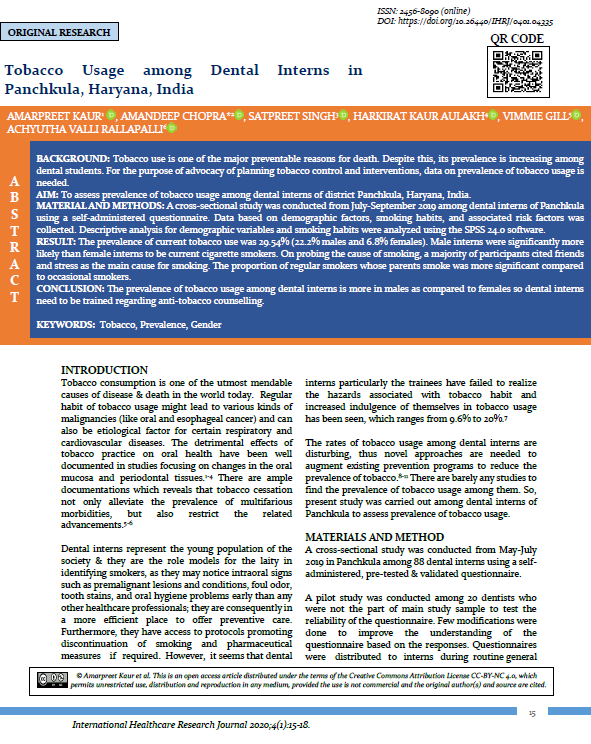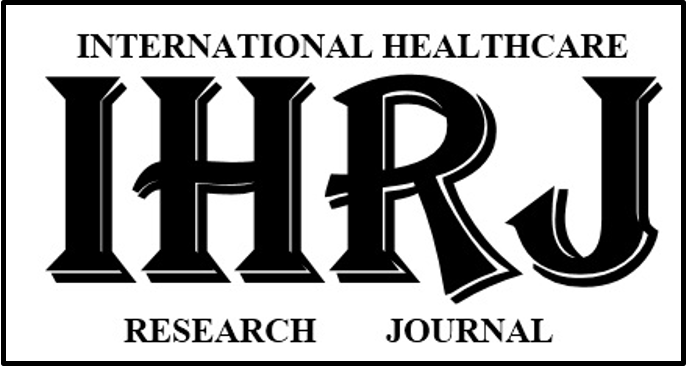Tobacco Usage among Dental Interns in Panchkula, Haryana, India
Abstract
BACKGROUND: Tobacco use is one of the major preventable reasons for death. Despite this, its prevalence is increasing among dental students. For the purpose of advocacy of planning tobacco control and interventions, data on prevalence of tobacco usage is needed.
AIM: To assess prevalence of tobacco usage among dental interns of district Panchkula, Haryana, India.
MATERIAL AND METHODS: A cross-sectional study was conducted from July-September 2019 among dental interns of Panchkula using a self-administered questionnaire. Data based on demographic factors, smoking habits, and associated risk factors was collected. Descriptive analysis for demographic variables and smoking habits were analyzed using the SPSS 24.0 software.
RESULT: The prevalence of current tobacco use was 29.54% (22.2% males and 6.8% females). Male interns were significantly more likely than female interns to be current cigarette smokers. On probing the cause of smoking, a majority of participants cited friends and stress as the main cause for smoking. The proportion of regular smokers whose parents smoke was more significant compared to occasional smokers.
CONCLUSION: The prevalence of tobacco usage among dental interns is more in males as compared to females so dental interns need to be trained regarding anti-tobacco counselling.
Downloads
References
Taybos G. Oral Changes Associated with Tobacco Use. Am J Med Sci. 2003;326(4):179-82.
Palmer RM et al. Potential mechanisms of susceptibility to periodontitis in tobacco smokers. J Periodontal Res. 1999; 34(7):363-9.
Zhou J, Olson BL, Windsor LJ. Nicotine increases the collagen‐degrading ability of human gingival fibroblasts, J Periodontal Res 2007;42:228-35.
Koshi R, Sugano N, Orii H, Fukuda T, Ito K. Microarray analysis of nicotine‐induced changes in gene expression in a macrophage‐like human cell line. J Periodontal Res 2007;42: 518-26.
Taylor DH Jr, Hasselblad V, Henley SJ, Thun MJ, Sloan FA. Benefits of smoking cessation for longevity. Am J Public Health. 2002;92(6):990–6.
Burns DM. Cigarette smoking among the elderly: disease consequences and the benefits of cessation. Am J Health Promot. 2000;14(6):357-61.
Shah MN. Health professionals in tobacco control: evidence from global health professional survey (GHPS) of dental students in India. New Delhi, India: World Health Organization; 2005.
Trinidad DR, Johnson CA. The association between emotional intelligence and early adolescent tobacco and alcoholuse. Pers Individ Dif. 2002;32:95‑105.
Dumitrescu AL. Tobacco and alcohol use among Romanian dental and medical students: A cross‑sectional questionnaire survey. Oral Health Prev Dent. 2007;5:279-84.
Dumitrescu AL. Attitudes of Romanian dental students towards tobacco and alcohol. J Contemp Dent Pract 2007; 8:64-71.
Mammas IN, Bertsias GK, Linardakis M, Tzanakis NE, LabadariosDN, Kafatos AG. Cigarette smoking, alcohol consumption, and serum lipid profile among medical students in Greece. Eur J Public Health. 2003;13:278-82.
Reddy KS, Gupta PC, editors. Report of tobacco control in India. New Delhi: Ministry of Health and Family Welfare, Government of India; 2004.
Thomas J, Kumar RBV, Akhil S, Saji AM, Iype A, Antony D. Prevalence of smoking among dental students and gauging their knowledge about tobacco cessation methods: An original study. J Family Med Prim Care. 2019;8(5):1562–6.
Al-Swuailem AS, Al-Shehri MK, Al-Sadhan S. Smoking among dental students at King Saud University: Consumption patterns and risk factors. Saudi Dent J. 2014; 26(3):88–95.
Sharma R, Grover VL, Chaturvedi S. Tobacco Use Among Adolescent Students and the Influence of Role Models Indian J Community Med. 2010;35(2):272–5.
Rani M, Bonu S, Jha P, Nguyen SN, Jamjoum L. Tobacco use in India: prevalence and predictors of smoking and chewing in a national cross sectional household survey, Tobacco Control 2003;12(4):e4.
Mukherjea A, Morgan PA, Snowden LR, Ling PM, Ivey SL. Social and cultural influences on tobacco-related health disparities among South Asians in the USA. Tobacco Control 2012;21(4):422–8.
Reddy KS, Shah B, Varghese C, Ramadoss A. Responding to the threat of chronic diseases in India. The Lancet 2005;366(9498):1744–9.
Arora M, Madhu R. Banning smokeless tobacco in India: policy analysis. Indian J Cancer. 2012;49(4):336–41.

Copyright (c) 2020 Amarpreet Kaur et al.

This work is licensed under a Creative Commons Attribution-NonCommercial 4.0 International License.


